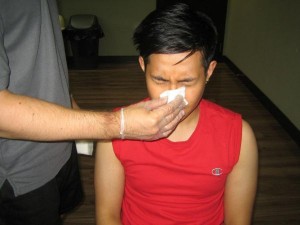Epistaxis, an acute bleeding episode or hemorrhage from the nose, is caused by the rupture of tiny, distended Vessels in the mucous membrane of any area of the nose as well as the innermost underlying structures of the nasal cavity. Rarely does Epistaxis originate in the densely vascular portions of tissue over the turbinates.

The location wherein most occurrences of Epistaxis would most likely originate in the anterior septum, where three major blood vessels enter the nasal cavity: (1) the anterior ethmoidal artery on the forward portion of the roof of the nasal cavity, (2) the sphenopalatine artery in the posterior-superior region of the nasal passage and (3) the internal maxillary branches (the plexus of veins located in the posterior-lateral wall under the inferior region of the nasal passage).
Risk factors for Epistaxis
Below are some of the risk factors that are highly associated with episodes of Epistaxis which include but not limited to the following:
- Systemic infection (scarlet fever, malaria)
- Local infection (rhinitis, sinusitis)
- Nasal inhalation of illicit and prohibited drugs (cocaine)
- Trauma (digital trauma which includes accidentally picking the nose, blunt trauma; fracture; indiscriminate and forceful nose blowing)
- Hypertension
- Arteriosclerosis
- Use of aspirin as well as other blood thinning agents
- Tumor growth (sinus or nasopharynx)
- Thrombocytopenia
- Liver disease
Medical Management for Epistaxis
Management of Epistaxis depends on its cause and the location of the bleeding site. A nasal speculum, penlight or headlight may be used to determine the site of bleeding in the nasal cavity. Most nosebleed originate from the anterior portion of the nose. Initial treatment may include applying direct pressure on the nose. The individual is advised to maintain an upright position with the head tilted forward to prevent swallowing and aspiration of blood and is directed to pinch the soft outer portion of the nose against the midline of the septum for five to ten minutes continuously. If this method is not successful, additional treatment is further indicated. In cases of anterior nosebleeds, the area may be treated with silver nitrate applicator or may be treated invasively by electrocautery if the bleeding is severe and profuse.
Prevalence and Prognosis of Epistaxis
Epistaxis can be subdivided into 2 main types namely anterior and posterior nosebleeds on the basis of the site where the bleeding is originating from. The prevalence of Epistaxis is relatively unknown mainly because most episodes are not profuse and are basically self-limiting which majority of people experiencing it do not report and seek medical attention. Medical attention is normally required when the bleeding episodes become recurrent and profuse which necessitate medical evaluation and treatment.
For the majority of the general population, Epistaxis is basically a medical nuisance. However, this condition can become life-threatening especially if the bleeding episode is profuse and severe enough to cause major compromise to the airway especially in elderly patients and in those with existing medical conditions. Prognosis is generally good depending on the intrinsic and extrinsic variables, but with prompt, proper treatment, adequate supportive care of underlying medical problems. Furthermore, only a small percentage of patients really require aggressive and invasive treatment from Epistaxis.
